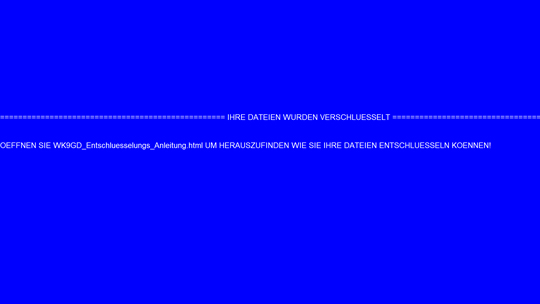Ransom.Win32.ENTSCRYPT.THHOAAIA
Trojan-Ransom.Win32.Gen.sds(Kaspersky); Trojan:Win32/Occamy.C(Microsoft)
Windows


Threat Type: Ransomware
Destructiveness: No
Encrypted:
In the wild: Yes
OVERVIEW
This Ransomware arrives on a system as a file dropped by other malware or as a file downloaded unknowingly by users when visiting malicious sites.
It drops files as ransom note.
TECHNICAL DETAILS
Arrival Details
This Ransomware arrives on a system as a file dropped by other malware or as a file downloaded unknowingly by users when visiting malicious sites.
Installation
This Ransomware drops the following files:
- {Encrypted Directory}{5 random characters (ext)}_Entschluesselungs_Anleitung.html → Ransom Note
- %User Temp%\wlp.bmp → set as a desktop background as a ransom note
(Note: %User Temp% is the current user's Temp folder, which is usually C:\Documents and Settings\{user name}\Local Settings\Temp on Windows 2000(32-bit), XP, and Server 2003(32-bit), or C:\Users\{user name}\AppData\Local\Temp on Windows Vista, 7, 8, 8.1, 2008(64-bit), 2012(64-bit) and 10(64-bit).)
Other System Modifications
This Ransomware sets the system's desktop wallpaper to the following image:
Other Details
This Ransomware does the following:
- It avoids encrypting files with the following extensions:
- .386
- .adv
- .ani
- .bat
- .cab
- .cmd
- .com
- .cpl
- .cur
- .deskthemepack
- .diagcab
- .diagcfg
- .diagpkg
- .dll
- .drv
- .exe
- .hlp
- .icl
- .icns
- .ico
- .ics
- .idx
- .ldf
- .lnk
- .mod
- .mpa
- .msc
- .msp
- .msstyles
- .msu
- .nls
- .nomedia
- .ocx
- .prf
- .psl
- .rom
- .rtp
- .scr
- .shs
- .spl
- .sys
- .theme
- .themepack
- .wpx
- .lock
- .hta
- .msi
- It avoids encrypting files with the following file names:
- autorun.inf
- boot.ini
- bootfont.bin
- bootsect.bak
- desktop.ini
- iconcache.db
- ntldr
- ntuser.dat
- ntuser.dat.log
- ntuser.ini
- bootmgr
- bootnxt
- thumbs.db
- This sample does not perform encryption but rather wipes the content of the files.
Ransomware Routine
This Ransomware avoids encrypting files found in the following folders:
- windows
- recycle.bin
- mozilla
- boot
- application data
- appdata
- program files
- program files(x86)
- programme
- programme (x86)
- programdata
- perflogs
- intel
- msocache
It appends the following extension to the file name of the encrypted files:
- {5 Random characters}
It drops the following file(s) as ransom note:
- {Encrypted Directory}{5 random characters (ext)}_Entschluesselungs_Anleitung.html

SOLUTION
Step 1
Before doing any scans, Windows 7, Windows 8, Windows 8.1, and Windows 10 users must disable System Restore to allow full scanning of their computers.
Step 2
Note that not all files, folders, and registry keys and entries are installed on your computer during this malware's/spyware's/grayware's execution. This may be due to incomplete installation or other operating system conditions. If you do not find the same files/folders/registry information, please proceed to the next step.
Step 3
Restart in Safe Mode
Step 4
Search and delete this file
- {Encrypted Directory}{5 random characters (ext)}_Entschluesselungs_Anleitung.html
- %User Temp%\wlp.bmp
Step 5
Restart in normal mode and scan your computer with your Trend Micro product for files detected as Ransom.Win32.ENTSCRYPT.THHOAAIA. If the detected files have already been cleaned, deleted, or quarantined by your Trend Micro product, no further step is required. You may opt to simply delete the quarantined files. Please check this Knowledge Base page for more information.
Step 6
Restore encrypted files from backup.
Step 7
Scan your computer with your Trend Micro product to delete files detected as Ransom.Win32.ENTSCRYPT.THHOAAIA. If the detected files have already been cleaned, deleted, or quarantined by your Trend Micro product, no further step is required. You may opt to simply delete the quarantined files. Please check the following Trend Micro Support pages for more information:
Step 8
Reset your Desktop properties
Did this description help? Tell us how we did.



